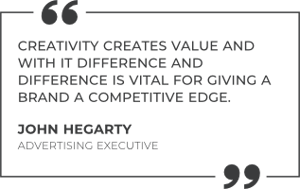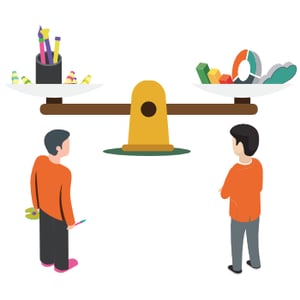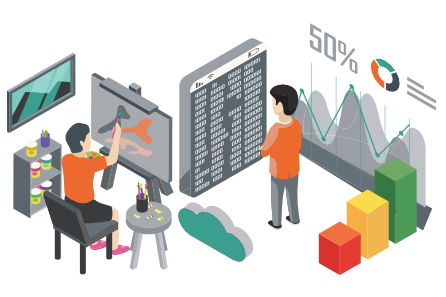I think we can all agree that there seems to be some sort of unspoken consensus among marketing professionals that data and creativity are somehow complete opposites.
 So, are the two mutually exclusive? Should marketers, whose profession has long relied on creativity and imagination, make a 180-turn and become hardcore data scientists?
So, are the two mutually exclusive? Should marketers, whose profession has long relied on creativity and imagination, make a 180-turn and become hardcore data scientists?
Data can help marketers take their creativity to the next level. In fact, the more data you have, the more questions you can ask of it. The more creative those questions are, the more you will differentiate yourself in the long-run.
Creativity without data is a shot in the dark

In a way, your gut feeling is a lot closer to big data than you might expect. What’s more, “technological advancements in market research can supercharge the creative process by providing rich insights into highly targeted niche consumer groups. When used correctly, data is not the enemy of creative; it can be its most powerful ally,” Weinstein adds.
How exactly can data and creativity work together?
It is important to understand that the two need to complement each other when making strong business decisions. Insights from big data sets can in no way replace your gut feeling but instead, they can refine it. It should add to your creativity and help perfect your ideas, After all, data may provide knowledge and new insights, but it cannot create an emotional bond with the consumer.
Striking a balance between data and creativity
 Having data and creativity in a symbiotic relationship sounds great, but it is often easier said than done. The rise of data has made brands and agencies alike feel the need to embrace it as part of their day-to-day business activities. While that has been more than a necessary step for industry players that want to stay competitive.
Having data and creativity in a symbiotic relationship sounds great, but it is often easier said than done. The rise of data has made brands and agencies alike feel the need to embrace it as part of their day-to-day business activities. While that has been more than a necessary step for industry players that want to stay competitive.
It has also created an environment where marketing has been forced into the sales space. The result is "an increasing reliance on data for justification, proof, and measurement", according to advertising company Adshel.
There is a risk that data can stifle creativity, which might produce content that’s not engaging. Data is there to help you formulate your content strategy, but shouldn’t be the only thing considered in the creative process. The challenge of handling increasing amounts of data on a daily basis is that it can, in fact, become too big of a focus. This leaves human interpretation and creativity behind. Understanding customers based on the data they generate is important.
“Creativity without data is just art. But data without creativity is neglect.”Steve Babcock, Chief Creative Officer at VaynerMedia
Brands and agencies need to be able to design their customer journey with the customer in mind, with data guiding them along the way. Embracing data analytics tools can help speed up data collection and processing. This will leave more time for marketers to generate insights and ask relevant questions.
The thing about creativity is that everyone has a personal preference for what they like and don’t like. In order to produce efficient ads and content, you need to have a clear understanding of what resonates with your audience. Try to merge creatives and data analysts together to brainstorm and mix up knowledge and ideas. This creates a data-centric culture and companies that do this can optimize their marketing campaigns more successfully.

Four reasons why you should marry data and creativity in your team
1. When analysts and creatives look at the data together, they can play with it, look beneath the surface and look for interesting connections. If you utilize this at an early stage, this collaboration can result in unique and powerful insights. It also tends to reveal new ways to work with the data.
2. Making room for the data analysts to share their findings helps steer creative briefs in the right direction. If creatives learn from project performance analysis, they will have a much better insight into emotional triggers that perform better for specific audiences.
3. When you marry data analysts and creatives, you will find that they will create interesting strategies for evolving marketing campaigns. This process should be viewed as a challenge to turn the numbers into something relatable for consumers. It will also help their data teams get a better insight into how human behaviors drive the numbers that they’re analyzing.
4. Creatives have a good sensibility for human truths and pain points, and data analysts know how to match different data sources to interpret and map these human truths.
“Marketers have to unite data, creative content, and technology to achieve success. Understanding your audience comes first, but using that information to create more relevant, valuable, creative, and empowering experiences for consumers is the path to greater business success. And that’s the future of how data drives value for brands.”Lisa Utzschneider, Chief Revenue Officer at Yahoo











